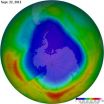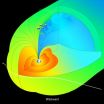(Press-News.org) Life is about failure as much as it is about success. From the mistakes we make at work or school to our blunders in romantic relationships, we are constantly reminded of how we could be better. By focusing on the important qualities that make us who we are – a process called self-affirmation – we preserve our self-worth in the face of our shortcomings.
Self-affirmation has been shown to have powerful effects – research suggests that it can minimize the anxiety, stress, and defensiveness associated with threats to our sense of self while keeping us open to the idea that there is room for improvement. But how does the process of self-affirmation actually work?
New research published in Psychological Science, a journal of the Association for Psychological Science, explores the neurophysiological reactions that could explain how self-affirmation helps us deal with threats to our self-integrity.
"Although we know that self-affirmation reduces threat and improves performance, we know very little about why this happens. And we know almost nothing about the neural correlates of this effect," says lead researcher Lisa Legault of Clarkson University.
Legault and her colleagues Michael Inzlicht of the University of Toronto Scarborough and Timour Al-Khindi of Johns Hopkins University posed several hypotheses. They theorized that because self-affirmation has been shown to make us more open to threats and unfavorable feedback, it should also make us more attentive and emotionally receptive to the errors that we make.
The researchers further hypothesized that these effects on attention and emotion could be measured directly in the form of a well-known brain response called error-related negativity, or ERN. The ERN is a pronounced wave of electrical activity in the brain that occurs within 100 ms of making an error on a task.
To test their hypotheses, the researchers randomly assigned 38 undergraduates to either a self-affirmation or a non-affirmation condition at the beginning of the study. In the self-affirmation condition, participants were asked to rank six values – including aesthetic, social, political, religious, economic, and theoretical values – from most to least important. They then had five minutes to write about why their highest-ranked value was important to them. In the non-affirmation condition, participants also ranked the six values, but they then wrote why their highest-ranked value was not very important to them. This was done in order to undermine self-affirmation in that group.
After ranking the values, the participants performed a test of self-control – the "go/no-go" task – in which they were told to press a button whenever the letter M (the "go" stimulus) appeared on a screen; when the letter W (the "no-go" stimulus) appeared, they were supposed to refrain from pressing the button. To increase the sense of threat in the task, participants were given negative feedback ("Wrong!") when they made a mistake.
While they were completing the go/no-go task, the participants' brain activity was recorded using electroencephalography, or EEG.
The findings suggest that self-affirmation improved participants' performance on the go/no-go task. Participants in the self-affirmation condition made fewer errors of commission – pressing the button when they shouldn't have – than did those in the non-affirmation condition.
But the participants' brain activity revealed an even more interesting story. While the self-affirmation and non-affirmation groups showed similar brain activity when they answered correctly, self-affirmed participants showed a significantly higher ERN when they made an error. This effect held up even after the researchers accounted for the number of errors of commission and errors of omission the participants made, in addition to their reaction times for the task.
Notably, the association between the ERN and the number of errors that participants made was stronger for the self-affirmed group. This suggests that self-affirmation enhanced the ERN response for those participants, which in turned predicted their performance on the task. The researchers speculate that participants who were self-affirmed were more receptive to errors which allowed them to better correct for their mistakes.
"These findings are important because they suggest one of the first ways in which the brain mediates the effects of self-affirmation," says Legault.
While these findings help to demystify the mechanisms that underlie self-affirmation, they may also have important practical implications. According to Legault, "Practitioners who are interested in using self-affirmation as an intervention tactic in academic and social programming might be interested to know that the strategy produces measurable neurophysiological effects."
Legault says that, ultimately, this research helps to show that "error-related distress, and our awareness thereof, can actually be a good thing."
###
For more information about this study, please contact: Lisa Legault at llegault@clarkson.edu.
The APS journal Psychological Science is the highest ranked empirical journal in psychology. For a copy of the article "Preserving Integrity in the Face of Performance Threat: Self-Affirmation Enhances Neurophysiological Responsiveness to Errors" and access to other Psychological Science research findings, please contact Anna Mikulak at 202-293-9300 or amikulak@psychologicalscience.org.
Self-affirmation enhances performance, makes us receptive to our mistakes
2012-10-25
ELSE PRESS RELEASES FROM THIS DATE:
NASA sees tiny Tropical Storm Tony traveling
2012-10-25
Satellite imagery indicated that Tropical Storm Tony is a small, compact storm, traveling through the central Atlantic Ocean.
On Oct 23, Tropical Depression 19 strengthened into Tropical Storm Tony in the central Atlantic Ocean. NOAA's GOES-13 satellite captured an image of Tony on Oct. 24 at 7:45 a.m. EDT that revealed that Tony is relatively small as it moves through the central Atlantic. Tropical storm force winds extend outward up to 70 miles (110 km) from the center. Tony is just over 140 miles in diameter as seen on the GOES-13 image. The GOES-13 satellite image ...
Living power cables discovered
2012-10-25
A multinational research team has discovered filamentous bacteria that function as living power cables in order to transmit electrons thousands of cell lengths away.
The Desulfobulbus bacterial cells, which are only a few thousandths of a millimeter long each, are so tiny that they are invisible to the naked eye. And yet, under the right circumstances, they form a multicellular filament that can transmit electrons across a distance as large as 1 centimeter as part of the filament's respiration and ingestion processes.
The discovery by scientists at Aarhus University ...
Americans use more efficient and renewable energy technologies
2012-10-25
Americans used less energy in 2011 than in the previous year due mainly to a shift to higher-efficiency energy technologies in the transportation and residential sectors. Meanwhile, less coal was used but more natural gas was consumed according to the most recent energy flow charts released by Lawrence Livermore National Laboratory.
Wind power saw the biggest jump from .92 quadrillion BTU, or quads, in 2010 up to 1.17 quads in 2011. (BTU or British Thermal Unit is a unit of measurement for energy and is equivalent to about 1.055 kilojoules).
"Wind energy jumped significantly ...
U of A medical researchers use simple intervention to improve osteoporosis treatment rates
2012-10-25
Older patients who visited local ERs for chest pain or breathing problems and had chest x-rays reveal unknown spinal fractures, were more apt to receive osteoporosis treatment afterward if a simple intervention was used, recently published medical research from the University of Alberta has found.
Treatment rates for the bone-thinning condition substantially improved when patients and their family doctors received follow-up information about the warning signs and risk factors. It is the first and only trial in the world that looked at spinal osteoporosis.
Of those ...
Pigs look healthy but test positive for flu at fairs; transmission seen between pigs and humans
2012-10-25
COLUMBUS, Ohio – More than 80 percent of pigs that tested positive for influenza A virus at Ohio county fairs between 2009 and 2011 showed no signs of illness, according to a new study.
Ohio State University researchers tested 20 pigs each at 53 fair events over those three summers and found at least one flu-positive pig at 12 fairs – almost a quarter of fairs tested.
The influenza strains identified in pigs in this study include H1N2 and H3N2 viruses – strains that have been circulating in pigs since 1998. In 2011, all of the H3N2 and H1N2 isolates found in pigs ...
Which candidate will be best for the stock market...?
2012-10-25
DeKALB, Ill. -- With Election Day less than a month away, television is filled with talking heads spreading the conventional wisdom of what a Republican or Democratic president might mean for the economy.
However, a group of researchers says, when it comes to the relationship between presidential politics and the behavior of the financial markets, conventional wisdom may not be so wise.
The researchers reviewed more than 40 years of data (1965-2008) in studying the relationship between security returns and four variables: the political affiliation of the president; ...
CU-Boulder researchers uncover new target for cancer research
2012-10-25
In a new paper released today in Nature, BioFrontiers Institute scientists at the University of Colorado Boulder, Tom Cech and Leslie Leinwand, detailed a new target for anti-cancer drug development that is sitting at the ends of our DNA.
Researchers in the two scientists' laboratories collaborated to find a patch of amino acids that, if blocked by a drug docked onto the chromosome end at this location, may prevent cancerous cells from reproducing. The amino acids at this site are called the "TEL patch" and once modified, the end of the chromosome is unable to recruit ...
2012 Antarctic ozone hole second smallest in 20 years
2012-10-25
WASHINGTON -- The average area covered by the Antarctic ozone hole
this year was the second smallest in the last 20 years, according to
data from NASA and National Oceanic and Atmospheric Administration
(NOAA) satellites. Scientists attribute the change to warmer
temperatures in the Antarctic lower stratosphere.
The ozone hole reached its maximum size Sept. 22, covering 8.2 million
square miles (21.2 million square kilometers), or the area of the
United States, Canada and Mexico combined. The average size of the
2012 ozone hole was 6.9 million square miles (17.9 ...
Plants provide accurate low-cost alternative for diagnosis of West Nile Virus
2012-10-25
While the United States has largely been spared the scourge of mosquito-borne diseases endemic to the developing world—including yellow fever, malaria and dengue fever—mosquito-related illnesses in the US are on the rise. One pathogen of increasing concern in the U.S. is an arbovirus known as West Nile.
Now Qiang "Shawn" Chen, a researcher at Arizona State University's Biodesign Institute and a professor in the College of Technology and Innovation has developed a new method of testing for West Nile, using plants to produce biological reagents for detection and diagnosis. ...
NASA study using cluster reveals new insights into solar wind
2012-10-25
A new study based on data from European Space Agency's Cluster mission shows that it is easier for the solar wind to penetrate Earth's magnetic environment, the magnetosphere, than had previously been thought. Scientists from NASA's Goddard Space Flight Center in Greenbelt, Md. have, for the first time, directly observed the presence of certain waves in the solar wind—called Kelvin-Helmholtz waves that can help transfer energy into near-Earth space—under circumstances when previous theories predicted they were not expected.
The recent paper, published on Aug 29, 2012, ...



